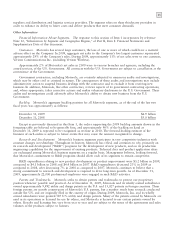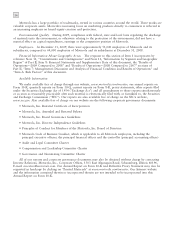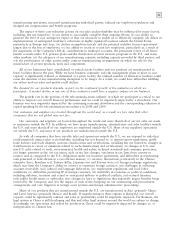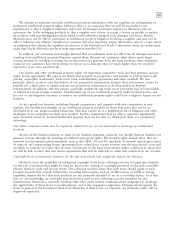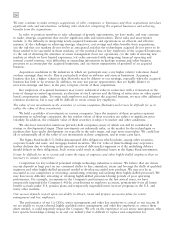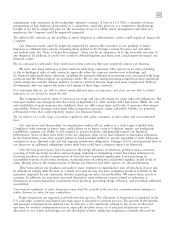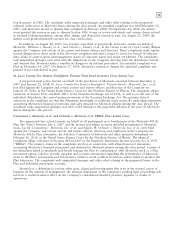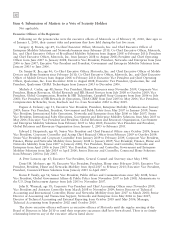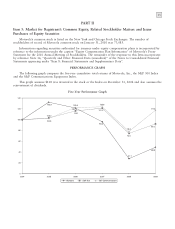Motorola 2009 Annual Report Download - page 31
Download and view the complete annual report
Please find page 31 of the 2009 Motorola annual report below. You can navigate through the pages in the report by either clicking on the pages listed below, or by using the keyword search tool below to find specific information within the annual report.
23
future, as we establish new pricing terms, our volume demand could negatively impact future pricing from
suppliers. All of these outcomes may result in our products being more costly to manufacture and less
competitive.
Industry convergence between telecom, data and media presents opportunities for our business, but also presents
risks.
We are affected by market conditions within the telecommunications, cable and broadband industries. We are
also affected by the convergence of the telecom, data and media industries, which is largely driven by
technological development related to IP-based communications. This change impacts our addressable market,
competition and our objective setting and strategies, as well as the need to consider risks to achieve our set
objectives. Should we not succeed in understanding the market development or acquiring the necessary
competence to develop and market products and solutions that are competitive in this changing market, our
business would be negatively impacted.
Our future operating results depend on our ability to purchase a sufficient amount of materials, parts and
components to meet the demands of our customers.
Our ability to meet customers’ demands depends, in part, on our ability to obtain timely and adequate
delivery of quality materials, parts and components from our suppliers. We have experienced shortages in the past
that have negatively impacted our operations. Although we work closely with our suppliers to avoid these types
of shortages, there can be no assurances that we will not encounter these problems in the future. Furthermore,
certain of our components are available only from a single source or limited sources. We may not be able to
diversify sources in a timely manner. A reduction or interruption in supplies or a significant increase in the price
of supplies could have a negative impact on our businesses.
The outcome of currently ongoing and future examinations of our income tax returns by the IRS could impact
our financial results.
We are subject to continued examination of our income tax returns by the Internal Revenue Service and
other tax authorities. We regularly assess the likelihood of adverse outcomes resulting from these examinations to
determine the adequacy of our provision for income taxes. There can be no assurance that the outcomes from
these continuing examinations will not have a negative impact on future operating results.
Many of our components and products are designed or manufactured by third parties and if third-party
manufacturers lack sufficient quality control or if there are significant changes in the financial or business
condition of such third-party manufacturers, it may have a negative impact on our business.
We rely on third-party suppliers for many of the components used in our products and we rely on third-
party manufacturers to manufacture many of our assemblies and finished products. If we are not able to engage
such manufacturers with the capabilities or capacities required by our business, or if such third parties lack
sufficient quality control or if there are significant changes in the financial or business condition of such third
parties, it could have a negative impact on our business.
We also have third-party arrangements for the design or manufacture of certain products, parts and
components. If we are not able to engage such parties with the capabilities or capacities required by our business,
or if these third parties fail to deliver quality products, parts and components on time and at reasonable prices,
we could have difficulties fulfilling our orders and our sales and profits could decline.
We may be required to record additional goodwill or other long-lived asset impairment charges, which could
result in an additional significant charge to earnings.
Under generally accepted accounting principles, we review our long-lived assets for impairment when events
or changes in circumstances indicate the carrying value may not be recoverable. Goodwill is tested for impairment
at least annually. Factors that may be considered in assessing whether goodwill or intangible assets may not be
recoverable include a decline in the Company’s stock price or market capitalization, reduced estimates of future
cash flows and slower growth rates in our industry. No goodwill or long-lived assets impairment charges were
recorded during 2009. During 2008, the Company recorded goodwill impairment charges of $1.6 billion and
intangible asset impairment charges of $136 million. The goodwill impairment charges resulted from lower asset
values in the overall market and the impact of the macroenvironment on the Company’s near-term forecasts. The
intangible asset impairments resulted from a change in a technology platform strategy. Further declines in the
Company’s stock price or reductions in the Company’s future cash flow estimates and future operating results




